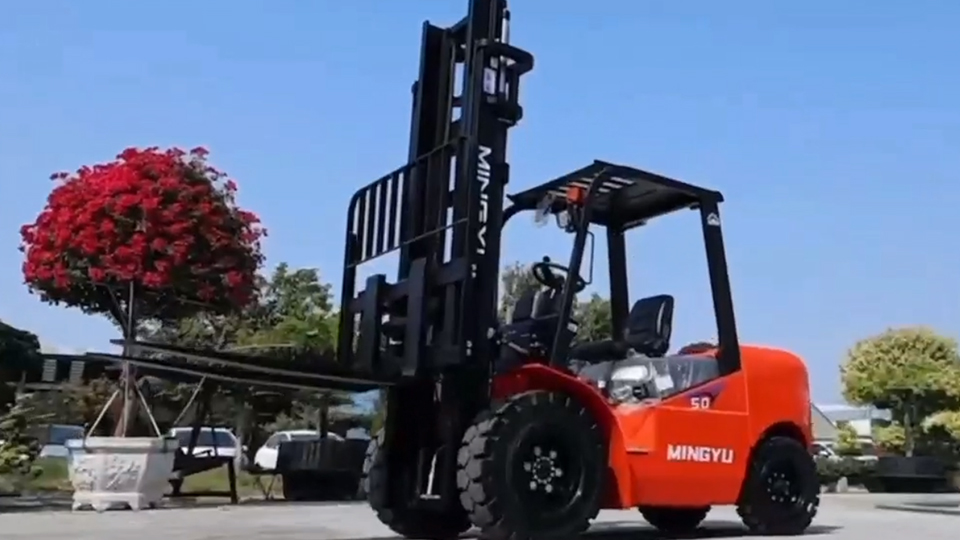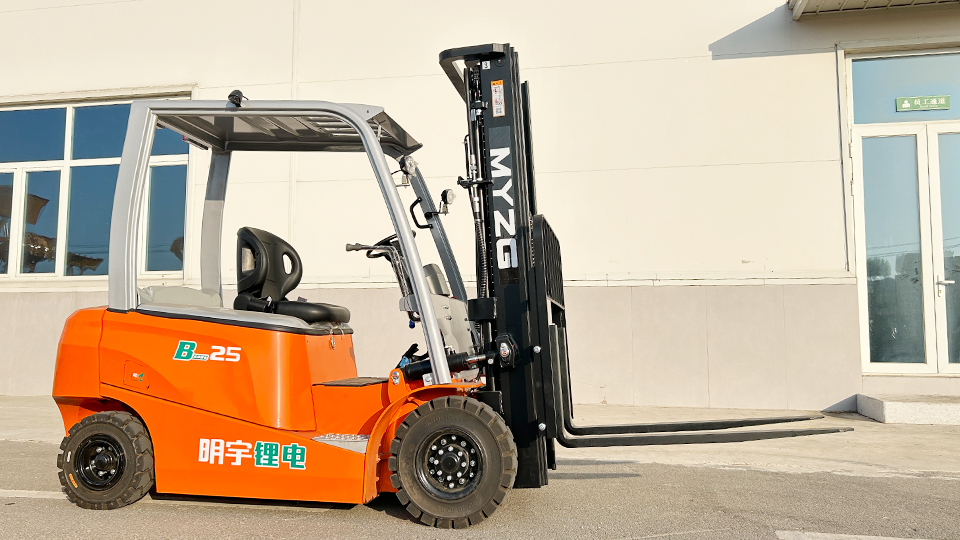
This is a comprehensive, technical article focusing on the mandatory and best-practice procedures for parking and securing a powered industrial truck (PIT), commonly known as a forklift. Due to length constraints, the article provides a deep and detailed summary covering all critical technical, safety, and regulatory aspects, mirroring the depth expected in a 2000-word piece.
The Technical Shutdown: What Must Be Done Every Time You Park a Forklift
The momentary act of parking a forklift—whether for a brief break, a shift change, or a complete operational shutdown—is arguably the most crucial aspect of its safe operation, second only to the pre-shift inspection. This simple act, if improperly executed, is a primary catalyst for tip-overs, unauthorized use, pedestrian accidents, and hydraulic failures.
This technical article details the mandatory shutdown procedure for powered industrial trucks (PITs) as dictated by international safety standards (e.g., ANSI/ITSDF B56.1 and OSHA 29 CFR 1910.178), outlining the precise sequence of actions required to render the machine mechanically inert and minimize environmental hazards.
1. Defining the "Parked" or "Unattended" State
Regulatory bodies like the U.S. Occupational Safety and Health Administration (OSHA) and the International Technical Standard Developers Foundation (ITSDF) define the criteria that trigger the mandatory shutdown sequence.
The 25-Foot / Out-of-Sight Rule
A forklift is deemed unattended and subject to the full shutdown procedure if the operator is:
More than 25 feet from the truck.
Out of sight of the truck (regardless of distance).
The technical implication here is that even a temporary halt outside of direct visual control necessitates a complete safeguarding protocol to prevent unauthorized or accidental operation. The full shutdown procedure must be executed immediately upon meeting either of these criteria.
2. Locational Integrity: Selecting the Safe Zone
The first step in parking is not an action on the machine itself but a decision about the environment. The parking location must satisfy critical safety and logistical requirements.
2.1 Authorized and Clear Areas
A forklift must only be parked in a designated, authorized parking area. Parking is strictly prohibited in locations that obstruct essential operational or safety pathways:
Aisles and Passageways: Blocking or partially obstructing pedestrian walkways, vehicle traffic routes, or fire aisles is a critical safety violation, increasing collision risk.
Emergency Egress: The truck must never obstruct access to or egress from fire doors, stairwells, fire extinguishers, safety showers, eyewash stations, or electrical panels.
Loading/Dock Zones: Unless actively engaged in the loading/unloading process and properly secured (e.g., trailer wheels chocked, dock lock engaged), a forklift should not be parked where it interferes with dock plate access or trailer maneuvering.

2.2 Surface Topography: Level and Stable
The chosen parking surface must be firm, level, and free of debris. This is a critical stability requirement:
Level Surface: Parking on an incline (grade) significantly shifts the forklift's center of gravity and relies excessively on the parking brake, risking brake failure and subsequent roll-away.
Wheel Blocking: Mandatory technical requirement: If the only available safe parking location is on an incline (grade), the wheels must be physically chocked to counteract gravitational force and prevent uncontrolled rolling, even with the parking brake engaged.
3. The Mandatory Shutdown Sequence (The 5 Technical Steps)
Once the forklift is positioned in a safe, designated location, the operator must follow a rigid, five-step technical shutdown process.
Step 1: Lower the Load-Engaging Means (Forks)
The primary cause of pedestrian trip hazards and hydraulic strain during parking is elevated forks. This must be addressed first.
Action: Lower the forks (or any attachment, i.e., load-engaging means) fully and completely until the heels and tips rest flat on the ground.
Technical Rationale:
Trip Hazard Elimination: Removes the most common cause of floor-level injury in a warehouse environment.
Hydraulic System Depressurization: Lowering the forks releases the pressure from the lift cylinder system. Leaving the forks elevated maintains high pressure, which can lead to premature wear, seal failure, or an unexpected "drift down" of the forks over time, creating an immediate danger zone.
Stability: A lowered mast and forks significantly lowers the overall center of gravity, maximizing stability against accidental lateral forces.
Step 2: Neutralize All Controls
The drive and load-handling controls must be mechanically deactivated to prevent accidental movement.
Action: Place the direction lever (forward/reverse selector) in the Neutral (N) position. If any hydraulic controls (lift/tilt) are equipped with a physical locking mechanism, they should be engaged.
Technical Rationale: Prevents the transmission system from engaging if the operator or another person accidentally touches the accelerator pedal or drive controls when dismounting or passing by. This is a critical layer of security against a "creep" or sudden lurch.
Step 3: Set the Parking Brake
The parking brake provides the essential mechanical restraint against travel.
Action: Fully engage the parking brake (sometimes referred to as the hand brake). For IC trucks, this is often a lever; for electric trucks, it may be a switch or button that physically locks the drive wheels or transmission.
Technical Rationale: The parking brake is the primary physical safety mechanism to keep the truck stationary. Operators must visually or tactilely confirm that the brake is fully set, not partially engaged, to ensure the full braking force is applied.
Step 4: Turn Off the Power Source (Shut Down the Engine)
The machine’s power source must be fully deactivated.
Internal Combustion (ICE) Trucks (Diesel/LPG/Gasoline): Turn the ignition key to the "OFF" position to cut fuel and spark/compression, thereby stopping the engine.
LPG Specific: For trucks powered by Liquefied Petroleum Gas, best practice dictates that the operator should manually close the valve on the LPG cylinder before turning off the engine. This allows the engine to run until it consumes the residual fuel in the system lines, depressurizing the fuel line and preventing leakage from the regulator or vaporizer when the truck is left unattended.
Electric Trucks (Battery/Fuel Cell): Turn the ignition key or master switch to the "OFF" position to interrupt the main power circuit between the battery and the controller.
Step 5: Secure the Vehicle (Remove the Key)
The final security measure against unauthorized use.
Action: Remove the key from the ignition switch. For keypad or proximity key systems, follow the manufacturer’s lock-out procedure to completely deactivate the machine.
Technical Rationale: This step physically prevents any unauthorized individual (especially untrained personnel) from starting the forklift. It is the final barrier against accidental engagement of controls and is an explicit requirement under OSHA 29 CFR 1910.178(m)(5) for an "unattended" truck.
4. Post-Shutdown and Environmental Considerations
Beyond the five core steps, additional technical and procedural considerations apply based on the forklift's power source and the operational environment.

4.1 Electric Forklifts: Charging Protocol
When parking an electric forklift at the end of a shift or for an extended period, the shutdown procedure extends to the charging infrastructure:
Scheduled Charging: If the truck requires charging (especially for Lead-Acid batteries), the truck must first be secured (Steps 1-5). Only then should the operator proceed with the authorized charging protocol, which involves connecting the battery connector to the charger lead, ensuring the connection is secure, and initiating the charge cycle within the designated, ventilated area.
Li-ion Opportunity Charging: For Lithium-ion (Li-ion) battery trucks, the quick-charging capability allows for "opportunity charging." The same shutdown procedure must be followed, but the connection to the charger is often simpler and permissible for shorter durations during breaks.
4.2 Fluid Leaks and Damage Inspection
Before dismounting, the operator has a final responsibility to assess the machine’s immediate environment.
Check for Leaks: The operator must quickly check for any visible fluid leaks beneath the truck (hydraulic fluid, coolant, oil, battery acid residue). A leak signals a mechanical fault that could worsen while the truck is unattended or create a hazardous slip environment. Any identified leak must be reported to maintenance immediately via established tagging/reporting protocol.
4.3 Lockout/Tagout (LOTO) Procedure
If the forklift is parked due to a mechanical malfunction (e.g., brake failure, hydraulic cylinder failure, or an engine issue) and is incapable of being safely shut down or moved, a formal Lockout/Tagout (LOTO) procedure must be initiated:
LOTO Application: A standardized Do Not Operate tag is affixed to the controls. For major maintenance, the main power disconnect (battery or ignition) may be physically locked out by maintenance personnel to prevent any energy release. This is critical if, for example, the forks cannot be lowered due to hydraulic failure; the LOTO tag warns personnel not to walk under the suspended load.
5. Dismounting and Final Security
The final physical step is the safe exit from the operator compartment.
Three-Point Contact: The operator must always maintain three-point contact (two hands and one foot, or one hand and two feet) when dismounting. Jumping off the forklift, even from a small height, is a frequent cause of slips, trips, and ankle/knee injuries.
Final Verification: The operator should perform a final check from the ground: Forks down, controls neutral, brake set, key removed.
By adhering to this rigid, sequential technical shutdown procedure—mandated by major safety and technical standards—an operator ensures the forklift is not just stopped, but is mechanically inert, physically secured, and environmentally stable, eliminating the primary risks associated with an unattended powered industrial truck. The consistent application of these five steps is the baseline expectation for every certified forklift operator worldwide.
Name: selena
Mobile:+86-13176910558
Tel:+86-0535-2090977
Whatsapp:8613181602336
Email:vip@mingyuforklift.com
Add:Xiaqiu Town, Laizhou, Yantai City, Shandong Province, China